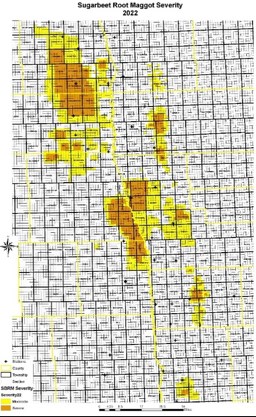629 - Sugarbeet Root Maggot Control 2023
Sugarbeet Root Maggot (SBRM) continues to increase its footprint in American Crystal’s growing area. 2022 saw the highest fly stake counts to-date, but timely control helped to reduce feeding damage.
Remember, maggots that live not only cause damage to this year’s crop but are also next year’s flies.
Aggressive control measures are required to control, stop, and hopefully shrink the expanding SBRM footprint. Unfortunately, this task has become more difficult as chlorpyrifos cannot be used in sugarbeets anymore since the EPA has revoked chlorpyrifos residue tolerances taking this control option away. Chlorpyrifos applications are not allowed on the sugarbeet crop. Any application will be subject to ACSC’s Misapplied Chemical Policy. |
|
2022 SBRM Fly Stake Counts were the highest to-date (Boetel NDSU)

Controlling SBRM populations is a two-fold process
1. Apply an effective At-Plant insecticide to control feeding SBRM larvae that hatch from the eggs the flies will lay.
- Counter At-Plant is the base to use for SBRM control
- Counter can only be applied once/season, has a 90-day PHI
- Neonicotinoids are: insecticide seed treatments (Poncho Beta, Nipsit, Cruiser) and Midac used in-furrow.
- These only provide suppression of SBRM larvae when used alone
- Dr. Boetel’s research shows there is increased control when seed treatments or Midac are combined with Counter or with each other At-Plant
2. Use well-timed, effective POST insecticides to knock down the SBRM fly population. This reduces the number of eggs that are laid and the resulting maggot population that the At-Plant insecticide must control.
- Thimet @ 7 lbs./acre applied 5-15 days before expected peak activity is a standard for control in severe SBRM areas
- Even when Thimet is used, a POST liquid insecticide treatment may be required to knock down the SBRM fly population if it is surging or if the Thimet was not activated with moisture.
- As fly populations surge, POST liquid insecticides (Mustang Maxx or Asana XL) should be applied prior to predicted “Peak Fly” at increments of 70-100 flies/stake.
- For fields without an At-Plant insecticide, POST insecticide treatment should be at increments of 40-45 flies/stake.
- Additional Post liquid insecticide treatments could be required if SBRM populations rebound.
Sugarbeet Root Maggot Resources
- 2023 ACSC SBRM Control quick card
Recommendations for insecticides, rates, and timing - Fly Stake Counts
NDSU and American Crystal Ag Staff take SBRM fly stake counts to monitor fly activity. Monitor your area’s numbers by following the below link. Counts are made every Monday, Wednesday, and Friday during SBRM season. - SBRM Degree Days (DD)
SBRM flies start to show up typically in the last week of May to first week of June. Peak Fly typically occurs at 651 DD.
 As always, please contact your Agriculturist with any questions and further refinement.
As always, please contact your Agriculturist with any questions and further refinement.
Important Notice: Please read and follow label directions on all pesticides, this web page is not a substitute.

